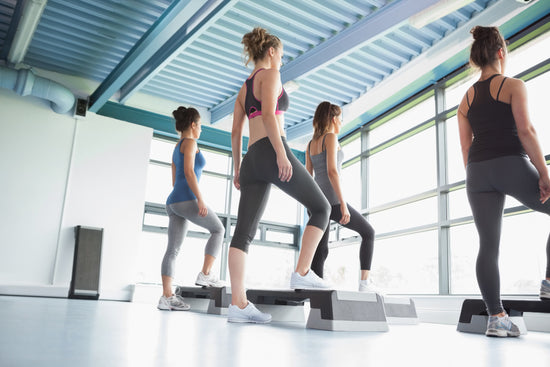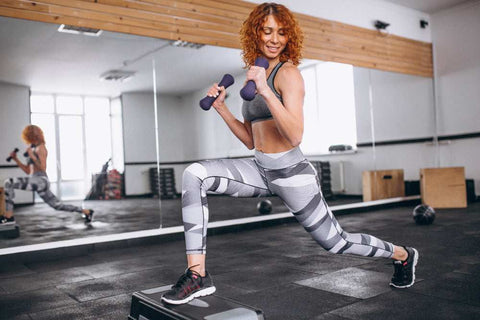Step Aerobics: Benefits and How to Do It at Home


Step aerobics, a form of aerobic exercise that involves repeated stepping onto a raised platform, has evolved significantly since its inception in the 1980s. Initially designed as a low-impact alternative to traditional aerobic workouts, step aerobics combines rhythmic movements with cardiovascular exercise, making it suitable for various fitness levels. The historical significance of step aerobics lies in its contribution to the fitness industry, introducing a modality that incorporates elements of music, choreography, and physical exercise, thus appealing to a broad audience.
In recent years, step aerobics has witnessed a resurgence, primarily due to its adaptability to home environments and its effectiveness in providing a comprehensive workout. This article aims to elucidate the fundamentals of step aerobics, delineate its health benefits, and offer guidance on executing these exercises at home, thereby catering to individuals seeking to enhance their physical well-being through accessible and efficient means.
Step aerobics involves sequences of choreographed movements performed on a raised platform known as a step. The core components of this exercise form include cardiovascular conditioning, coordination, and rhythm. As noted by Dr. Angela Patterson, a specialist in physical therapy, "Step aerobics facilitates cardiovascular health and endurance, engaging multiple muscle groups through coordinated, rhythmic patterns."
Unlike high-impact aerobics, which can exert substantial stress on joints, step aerobics provides a lower-impact alternative, reducing the risk of injury. This characteristic renders it an inclusive option, suitable for a diverse range of individuals, including those with joint concerns. Additionally, step aerobics allows for variable intensity, accommodating different fitness levels by adjusting the height of the step and the complexity of movements.
The primary requirement for step aerobics is a step platform. Its size and height vary, but standard dimensions are approximately 90 cm in length and 20 cm in height. Dr. Marcus Tan, an expert in exercise physiology, advises, "Choosing an appropriate step height is crucial; it should allow the knee to bend at a 90-degree angle when stepping." Furthermore, a clear, non-slippery space is essential for safe practice, ensuring ample room for movement around the step.
The health and fitness benefits of step aerobics include improved cardiovascular health, effective weight loss and management, enhanced muscle toning and strength, mental health benefits such as stress reduction, and improved coordination and balance. This workout is suitable for various fitness levels and can be adapted to individual needs, making it an inclusive and beneficial exercise option.
Step aerobics significantly enhances cardiovascular health, as evidenced by a 2019 study which observed a marked improvement in heart rate variability among participants following a 12-week step aerobics program. This form of exercise elevates the heart rate into the aerobic zone, promoting heart health and efficiency.
Engaging in step aerobics burns calories, thereby aiding in weight management. The amount of calories burnt depends on the intensity of the workout and the individual's weight, but on average, a person can burn between 400 and 500 calories per hour.
This exercise not only targets the lower body muscles, such as the quadriceps, hamstrings, and glutes, but also engages the core and upper body when incorporating arm movements and weights, leading to improved muscle tone and strength.
The rhythmic nature of step aerobics, combined with music, contributes to mental well-being, reducing stress and anxiety levels. Dr. Emily Saunders, a psychologist specialising in exercise psychology, states, "The combination of music and movement in step aerobics can significantly elevate mood and decrease stress."
Regular participation in step aerobics improves coordination and balance, as the routines require synchronisation of movements and maintaining stability on the platform.
Selecting a suitable step platform is pivotal; it should be sturdy, have a non-slip surface, and support the individual's weight. The height should be adjustable to cater to different skill levels and physical conditions.
Safety in step aerobics entails maintaining proper posture, wearing appropriate footwear, and being mindful of the body's limits. Dr. Patterson recommends, "Ensure the area around the step is clear of obstructions to prevent accidents."
Beginners should start with fundamental moves such as the basic step, side step, and knee lifts, gradually progressing to more complex combinations as proficiency increases.
A balanced step aerobics routine should include a warm-up, a cardio segment, strength-training elements, and a cool-down. This structure ensures a holistic workout that addresses various fitness components.
Creating an effective step aerobics routine requires a structured approach, starting with a warm-up to prepare the body for increased activity. Dr. Tan emphasises, "A proper warm-up should last at least five to ten minutes, incorporating gentle stepping and stretching to increase blood flow and reduce the risk of injury." The main segment of the workout should gradually increase in intensity, combining various step movements to target different muscle groups and enhance cardiovascular fitness. Concluding with a cool-down, which involves slower movements and stretching, is essential to aid in recovery and reduce muscle stiffness.
For a holistic approach, integrate strength training and flexibility exercises into your step aerobics routine. Dr. Patterson suggests, "Incorporating weights or resistance bands can enhance muscle strength, while dedicated stretching sequences can improve flexibility and range of motion."
Beginner Routine: Start with basic steps and gradually introduce side steps and knee lifts. Focus on maintaining proper form and stability. Duration: 20 minutes.
Intermediate Routine: Include more complex combinations such as V-steps, turn steps, and straddle downs. Introduce light hand weights for added resistance. Duration: 30 minutes.
Advanced Routine: Combine high-intensity movements like jump steps, over-the-tops, and power jacks. Incorporate intervals of strength training using heavier weights. Duration: 45 minutes.
To prevent boredom and plateaus, modify your step aerobics routine regularly by changing the step combinations, adjusting the step height, or varying the workout duration and intensity. Dr. Saunders states, "Variety not only keeps the routine interesting but also challenges different muscle groups and improves overall fitness." Continue for 19 Best Effective Fitness Exercise
Music plays a pivotal role in step aerobics by setting the workout's pace and enhancing motivation. Select music that complements your routine's intensity and rhythm. Choreography can add an enjoyable and creative element, making the workout more engaging.
Joining online classes or community groups can provide support and motivation. Sharing experiences and goals with others can foster a sense of accountability and encouragement, enhancing the overall exercise experience.
Dr. Tan warns against over-exertion: "Listen to your body and recognise signs of fatigue. Overdoing it can lead to injury." Ensure to pace yourself and rest when needed.
Maintaining proper form is crucial to avoid injury. Dr. Patterson advises, "Ensure your foot fully lands on the step and your knee is aligned over your ankle when stepping up."
Skipping the warm-up and cool-down phases can increase the risk of injury and delay recovery. Incorporate sufficient time for both at the beginning and end of your workout.
Establish clear, achievable goals related to your fitness level and step aerobics performance. Dr. Saunders recommends, "Set specific targets, such as duration, frequency, or complexity of routines, and gradually increase them."
Monitor your progress by noting improvements in endurance, strength, and flexibility. Recording the completion of each workout and any increases in step height or routine complexity can provide tangible evidence of advancement.
As you progress, adjust your routine to maintain challenge and effectiveness. Dr. Tan suggests, "Regularly reassess your goals and workout intensity to ensure they remain aligned with your fitness journey."

Yes, step aerobics is an effective workout. It combines cardiovascular exercise with strength training and can be adapted to all fitness levels. Step aerobics improves heart health, increases endurance, and helps in muscle toning. By varying the step height and routine intensity, individuals can customize their workouts to meet their fitness goals.
Yes, you can lose weight with step aerobics. It is a high-energy cardiovascular workout that can burn a significant number of calories, particularly when performed regularly and combined with a balanced diet. The exact number of calories burned will depend on the intensity of the workout, the duration, and the individual’s body weight.
People may have reduced their participation in step aerobics due to the rise in popularity of other fitness trends such as yoga, Pilates, and high-intensity interval training (HIIT). Additionally, misconceptions about the difficulty level or the mistaken belief that it is outdated may have contributed to a decline. However, step aerobics remains an effective workout option and has maintained a dedicated following.
Yes, 20 minutes of step aerobics can be enough, especially for beginners or those looking for a quick, effective workout. While longer sessions may provide additional benefits, especially for endurance building and weight loss, a focused 20-minute routine can still offer significant cardiovascular and muscle-toning benefits. Consistency and intensity are key factors in determining the effectiveness of the workout.
Step aerobics offers a versatile, effective, and enjoyable way to improve physical fitness. By understanding the fundamentals, incorporating variety, and adhering to safety guidelines, individuals can benefit significantly from this form of exercise. Regularly measuring progress and setting realistic goals are essential to maintain motivation and achieve long-term success. With commitment and the right approach, step aerobics can be a rewarding component of an overall fitness regimen.
Plus get the inside scoop on our latest content and updates in our monthly newsletter.